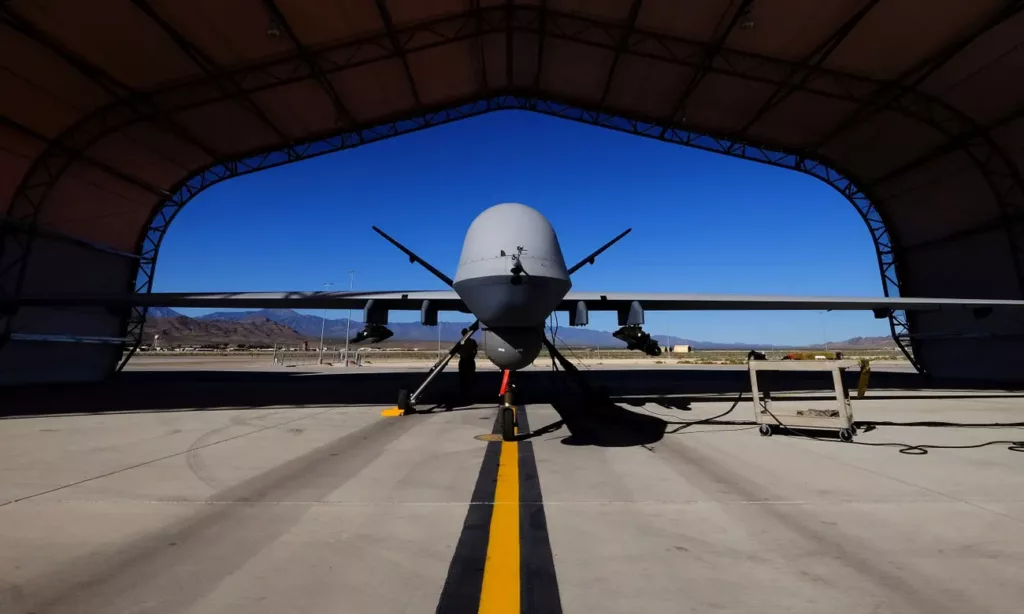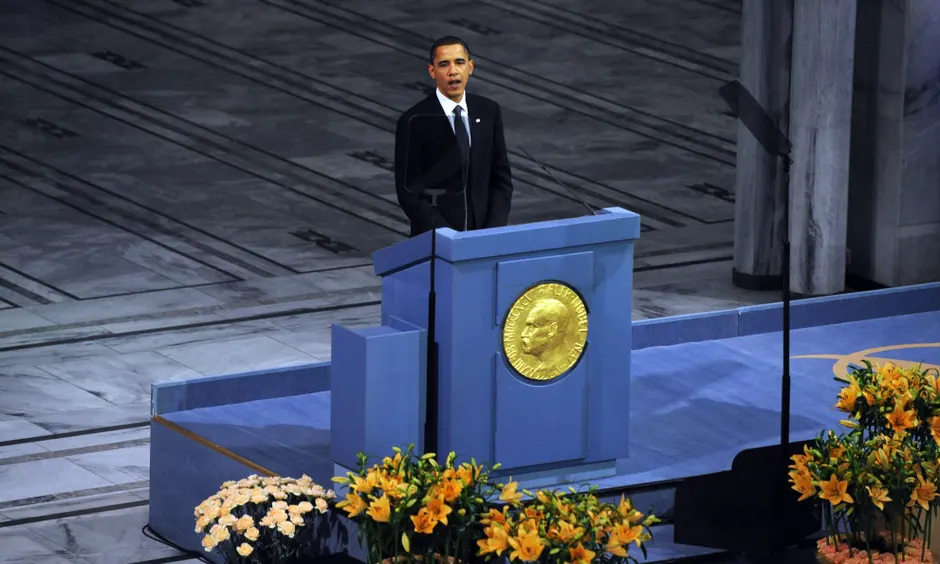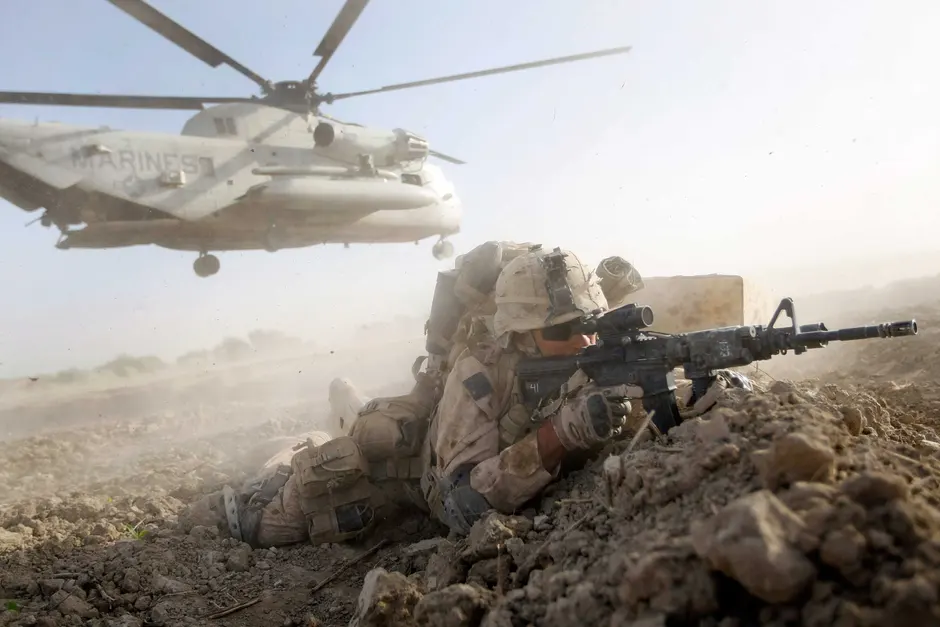How the US Created a World of Endless War
MILITARISM, 6 Sep 2021
Samuel Moyn | The Guardian – TRANSCEND Media Service
In 2008, many of Barack Obama’s supporters hoped he would bring the global war on terror to a close. Instead, he expanded it – and his successors have done nothing to change course.
31 Aug 2021 – On 23 May 2013, the peace activist Medea Benjamin attended a speech by President Barack Obama at Fort McNair in Washington DC, where he defended his administration’s use of armed drones in counter-terrorism. During his speech, Benjamin interrupted the president to criticise him for not having closed Guantánamo Bay and for pursuing military solutions over diplomatic ones. She was swiftly ejected by military police and the Secret Service. The Washington Post later dismissed her as a “heckler”. Obama himself had been more reflective at the event, engaging with her criticisms, which led to even deeper self-criticism of his own. It was the moment of greatest moral clarity about war during a presidency that did more than any other to bring its endless and humane American form fully into being.
For all its routine violence, the American way of war is more and more defined by a near complete immunity from harm for the American side and unprecedented care when it comes to killing people on the other. Today, there are more and more legal obligations to make war more humane – meaning, above all, the aim of minimising collateral harm. Countries like the US have agreed to obey those obligations, however permissively they interpret them and inadequately apply them in the field. Absolutely and relatively, fewer captives are mistreated and fewer civilians die than in the past. Yet, at the same time, the US’s military operations have become more expansive in scope and perpetual in time by virtue of these very facts.
The very idea of more humane war may seem a contradiction in terms. The US’s conflicts abroad remain brutal and deadly, but what’s frightening about them is not just the violence they inflict. This new kind of American war is revealing that the most elemental face of war is not death. Instead, it is control by domination and surveillance.
Obama had run as a kind of anti-war candidate in his fairytale 2008 campaign, and when it turned out that he was a hard-bitten pragmatist, in this and other areas, many of his supporters were surprised. Obama expanded the “war on terror” to an awesome extent, while making it sustainable for a domestic audience in a way his predecessor never did – in part because Obama understood the political uses of transforming American warfare in a humane direction.
In just the first few months of 2009, after Obama took the oath of office, the initial metamorphosis of American war into humane form was achieved. As the worst sins of the prior administration were disowned, Obama’s lawyers claimed authority to continue war indefinitely across space and time, devising formal legal frameworks for targeted killings. The rise of the armed drone empire under Obama’s watch was merely the symbol of the extension and expansion of endless war.
“Lawyerliness suffused the Obama administration,” observed Charlie Savage, the New York Times reporter who broke many explosive national security stories during the Obama years. But that lawyerliness often served as an elaborate rationalisation process. The president’s men and women, Savage has written, “were trying to fight al-Qaida while adhering to what they saw as the rule of law”. Though what they saw as the rule of law meant little more than self-regulation, their commitment to humane standards of fighting war – while by no means perfect in legal theory or military practice – had rhetorical power for some Americans, significant effects on the fighting itself, and helped produce endless war.
Obama continued a process begun in the later Bush years, but he more credibly advertised the country’s uprightness as steward of the least-brutal form of war possible. And he transformed the “war on terror” itself. Expansion and humanisation went together, branding Obama’s wars with an ominous trademark.
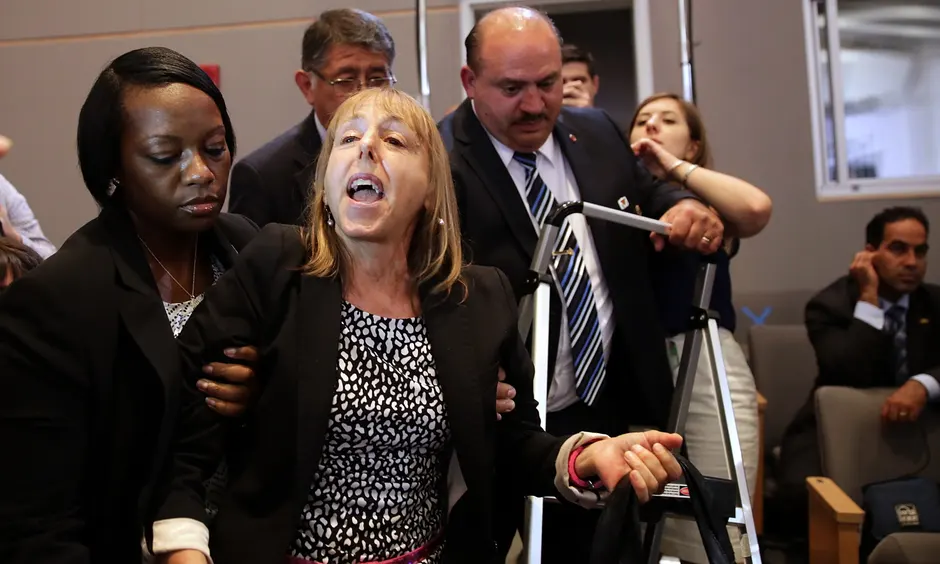
Medea Benjamin, being ejected from Obama’s talk at the National Defense University, Washington, in 2013. Photograph: Win McNamee/Getty Images
Beyond its other shortcomings, the transformation of American war incurred a gargantuan risk that its defenders and its opponents largely failed to notice before it was too late. In November 2016, it blindsided them. “He has relentlessly questioned the efficacy of force,” said the journalist Jeffrey Goldberg toward the end of Obama’s two terms, “but he has also become the most successful terrorist-hunter in the history of the presidency, one who will hand to his successor a set of tools an accomplished assassin would envy.” This outcome was scary, no matter how tightly controlled, humanely practised and judiciously governed – and that was before the true identity of Obama’s successor became known only six months after Goldberg wrote.
It was not as though Obama could have turned a blind eye to terrorism. He was a politician whose career depended on protecting the American people. But not only did Obama design a far bigger and more encompassing form of war than necessary, and not only did he undermine the US’s earlier commitments to a legal order consecrating peace to do so. His policies helped create the conditions for a shocking and terrible finale.
No dove, Donald Trump nevertheless capitalised on the perception that mainstream politicians were committed to endless wars. And he won. The arc of the moral universe ran through the humanisation of interminable conflict. But it bent toward an ogre. More and more humane forms of fighting abroad had now brought disaster at home, too. Then Trump went on to repeat the very same pirouette from anti-war candidate to endless war president that Obama had performed. And now Joe Biden risks doing the same.
In March 2009, a landmark legal brief gave clear, jaw-dropping notice of how Obama’s wars would be conducted, formalising and globalising the “war on terror” in a way that Bush had never done officially. There would be no limitations in space or time on the conduct of counter-terrorism. This would matter much more than Obama’s more widely remarked reforms: symbolically banning torture or fiddling with prisoner and trial rules.
Two months later, Obama met in the Oval Office with a group of civil libertarians and human rights advocates. “No one questions your values,” began Anthony Romero, the American Civil Liberties Union head. “But when your substantive policies are not substantively different from your predecessor’s, then the comparisons are fair.”
Later that year, Obama was awarded the Nobel Peace prize and in December, he travelled to Oslo to give his dazzling acceptance speech. The premise of his Nobel lecture was that terrorism, which he privately described (according to interviews) as a boring regulatory quandary, was so new and threatening that it required thinking “in new ways about the notions of just war and the imperatives of a just peace”. No matter the illusions some had cultivated when Obama ran, for a president, at least of the United States, an anti-war stance in power was out of the question.
All respect was due to his elected ancestor Martin Luther King’s rejection of war when he won his own Nobel in 1964 with the message that violence “solves no social problem: it merely creates new and more complicated ones.” But neither King nor Mohandas Gandhi before him had led a great nation.
It was a brilliant self-defence, not only of the ethics of Obama’s own role, but of American violence in a world where, he insisted, too many naively demand peace. “In many countries,” Obama remarked, “there is a deep ambivalence about military action today, no matter what the cause. And at times, this is joined by a reflexive suspicion of America, the world’s sole military superpower.” As the New York Times editorialists pointed out in lauding Obama’s rhetoric, “he directly challenged the widespread ambivalence and aversion” toward the Afghan war among Americans, too.
In his eloquent rationale for the uses of US military power for a new age, the saving grace, perhaps, was that Obama insisted on humane constraints. He recalled the US’s onetime contribution to a less war-torn globe, that is, after the second world war, constructing the international systems and institutions that were intended to reduce international conflict. And that contribution during and after the cold war left the world a “legacy for which my own country is rightfully proud”, though there may have been costs and mistakes along the way. But in the face of terror, what the American contribution required was not an end to war but precisely playing by the rules of humane warfare.
“I am convinced that adhering to standards, international standards, strengthens those who do, and isolates and weakens those who don’t,” he concluded. Obama was clear: “I believe the United States of America must remain a standard-bearer in the conduct of war.”
Obama turned to armed drones more times in his first year alone than Bush had in the entirety of his presidency. Almost from the start, Obama’s policy called for engaging in targeted killing, not only by drone but also with the Special Forces or standoff missiles sent from long distances. Introduced in secret and then normalised in public, targeted killings transformed the “war on terror” so that it stretched further and further across the Earth.
By the end of Obama’s time in office, drones had struck almost 10 times more than under his predecessor’s watch, with many thousands dead. The air force now trained more drone operators than aircraft pilots, and the bases and infrastructure of drone activity had been extended deep into the African continent, not merely across the Middle East and south Asia. Meanwhile, light-footprint Special Forces operated in or moved through 138 nations – or 70% of all countries in the world – in Obama’s last year in office. Actual fighting took place in at least 13, and targeted killing in some of those.
The attractions of this approach were clear. First and foremost was the need to get the war off the US’s front pages, and stop body bags from coming home. What’s more, Obama was genuinely concerned by the threat of domestic terror attacks. The month after the Nobel speech, on Christmas Day, the near destruction of Northwest Flight 253 en route from Amsterdam to Detroit by the Nigerian terrorist Umar Farouk Abdulmutallab, “the underwear bomber”, caused Obama enormous consternation. The near miss led the president to intensify in practice what he had defended in theory and his lawyers had blessed.
An equally enormous incentive was the need to avoid the damaging political attacks that his predecessor had suffered for the treatment of captured prisoners at Abu Ghraib and Guantánamo, along with the CIA’s black sites. If no one was captured, no one could be mistreated. But beyond these factors, Obama embraced the ideal of humanity in warfare not merely as what the law required but as a morally legitimate and legitimating enterprise.
The enlargement of the “war on terror” through targeted killings, and its extension in space or time, initially received little public scrutiny. The world had reacted with horror when Bush’s national security strategy in 2002 had forthrightly claimed the need to engage in pre-emptive self-defence without any imminent threat. In what sceptics regarded as an absurd oxymoron, Obama’s lawyers now invoked the “elongated imminence” of threats they said justified force. Not only was targeted killing allowed in self-defence, but Obama also asserted the legality of doing it pre-emptively.
Then there was the extraordinary way the law was stretched to cover new terrorist groups, as Obama’s war expanded to new places. Domestic law posed little barrier to targeted killing itself, at least for non-Americans, because in its Authorization for the Use of Military Force, Congress had allowed armed force to be used against any “persons” connected to the September 11 attacks. But it became a burning question whether a rapidly changing al-Qaida and new copycat groups that claimed its name were close enough to those involved in September 11 to earn legalised death. In the landmark March 2009 legal brief, Obama’s lawyers drew on the Bush-era notion of “associated forces” of al-Qaida in order to expand the range of legal targets. It was applied to groups such as the Islamist al-Shabaab outfit in Somalia with few or no ties to al-Qaida, and to individuals in virtue of their membership in this and other far-flung outfits. In 2014, to justify military action against Islamic State without needing to get congressional signoff, Obama’s lawyers deemed Isis to be Osama bin Laden’s “true inheritor”.
There were legal arguments for each of the steps Obama took, their credibility differing from case to case. Taken together, however, they blessed an expanding “war on terror” with unpredictable consequences. Nor were these kinds of legalistic sleights of hand confined to counter-terrorism. In 2011, the US commenced a United Nations authorised humanitarian intervention in Libya but transformed it into an illegal regime change, with deplorable consequences for that country. The Libya operation depended on an essentially unlimited rationale for presidential war that the attorneys provided.
If so little of this registered in mainstream US public debate, it was because the Obama administration emphasised the humanity of the fighting. From summer 2011 onwards, the drone programme began to receive more intense scrutiny in the press. The Obama administration would partially and strategically lift secrecy over the years that followed. By doing so, it normalised targeted killing – not hard to do given the enthusiasm for the death of Osama bin Laden in Pakistan on 2 May 2011, in a dramatic commando raid. At the same time, it set out to demonstratively minimise collateral harm. If the alternative to targeted killing was indiscriminate killing, and if the alternative to drones was full-on wars like Iraq or Vietnam, then it seemed obvious to many that Obama’s way was the right one.
Early statements for public consumption absurdly claimed that no collateral damage was being inflicted in these targeted killings, which outside reporting easily contradicted. “We’re exceptionally precise and surgical,” enthused John Brennan, Obama’s chief counter-terrorism adviser, in June 2011. He claimed that US counter-terrorism operations had not involved a single “collateral death” in almost a year “because of the exceptional proficiency and precision of the capabilities we’ve been able to develop”.
That was far from the truth. Obama himself had been so upset by excesses in the new incursion he ordered into Yemen that he stopped the drone attacks there for a year between 2010 and 2011. Most hard to reconcile with the idea of humane war were reports of the US carrying out “signature strikes”. These targeted males of fighting age in a given area without certainty that they were individually terrorists, let alone threatening ones. It was a presumption reminiscent of the Vietnam-era practice of declaring “free-strike” zones in which anyone remaining was presumptively an enemy. As the “war on terror” wore on, administration estimates of civilian casualties were raised, even as outside monitors reached much higher totals.
Most of the early critiques of targeted killing concerned how the humane standards of the laws of war applied. This focus anticipated the debate of the later Obama administration, which was whether too many innocent people were dying, not whether the interventions themselves were legal, where American force could go and how long it could stay.
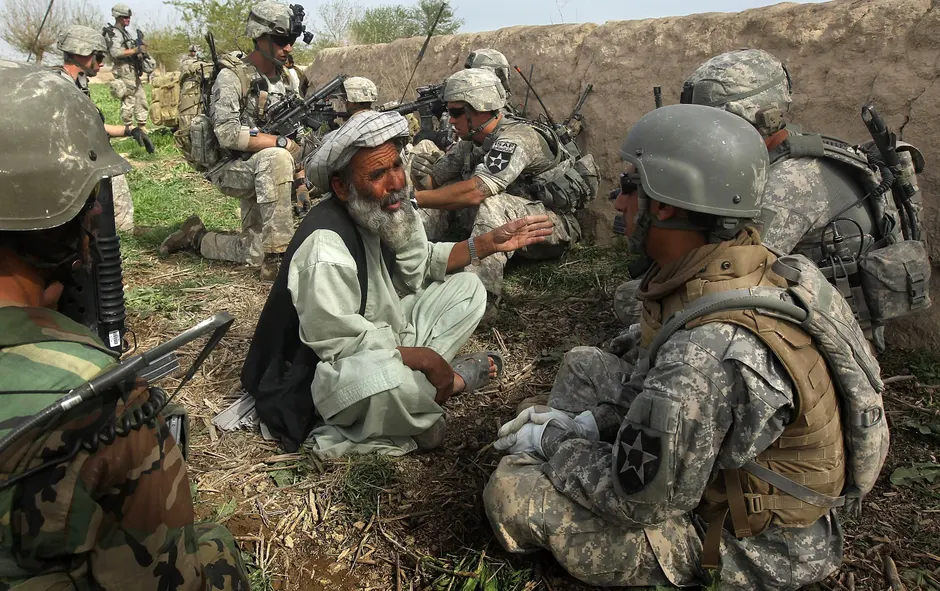
US and Afghan soldiers question a farmer after a firefight with the Taliban in Kandahar province, Afghanistan, in 2010.
Photograph: John Moore/Getty Images
As he ran for re-election in 2012, aware that someone else could inherit the system he had built, Obama began a process to codify drone policy. He even told Jon Stewart on an episode of The Daily Show two weeks before winning that he wanted a “legal architecture” to make sure that “not only am I reined in, but any president’s reined in”. And after winning, he gave his speech at the National Defense University at Fort McNair divulging that he had issued an executive order a year earlier clarifying the humane controls his administration placed on targeted killing.
This Presidential Policy Guidance (PPG) was an essential document. Where the March 2009 legal brief signalled war without limits in time or space, the PPG belatedly promised that it was to be humanely conducted. It promised that outside areas of active hostilities, and “absent extraordinary circumstances”, no killing would occur unless capture was “infeasible” and there was a “near certainty” that no one other than the terrorists would suffer. And where Bush had given the CIA blanket authority to strike anywhere, Obama demanded oversight. He met weekly to pore over “kill lists” that he personally vetted, and formally committed to doing so in the guidance document.
Written in 2012, the PPG was only publicly released two years later. Harvard Law professor Naz Modirzadeh cuttingly described the document as mixing together a number of “legal-ish” standards. The optics of humane behaviour, Modirzadeh suggested, were “being used to give an international law-like gloss” to “an approach that most allies see as violating” other parts of international law, most of all the rules controlling force.
The lawyer Martin Lederman, a former Obama official, took umbrage. How could anyone, he wondered, have the effrontery to complain about the attempt to humanise the war? Brutal war was worse than humane war, right? Lederman did not confront whether humanisation could work as a spoonful of sugar intended to help the medicine of endless war go down.
One of the insidious results of the humanisation of endless war was to prompt activists to demand even more humane war. Obama offered something between war and policing. Why not go all the way, these critics reasoned. If war was going to occur off battlefields and without time limit, so the argument went, it really ought to resemble the permanent institution of policing with its far more stringent rules on killing, only now on a global scale. But this was an extremely risky argument. In order to implore maximum humanisation, it conceded that illegal war could be endless and everywhere. Did the humanisation of so nightmarish a practice as endless global war make it better or worse?
Humanitarian and military lawyers bickered around how much wartime humanity was going to be enough. They tacitly agreed not to fight over the war itself. The campaign to seek more humane war did not challenge the enterprise of war itself.
As his encounter with the peace activist Medea Benjamin in 2013 proved, Obama himself hoped to stand for humanising the war from the top. But after Benjamin’s unceremonious removal from the audience, on stage, with his trademark calm and intellectualism, Obama openly wondered whether the strides toward humane war he himself demanded could come at a price.
“The voice of that woman is worth paying attention to,” Obama meditated off-script, surprising his audience. “Obviously I do not agree with much of what she said, and obviously she wasn’t listening to me in much of what I said. But these are tough issues, and the suggestion that we can gloss over them is wrong.” Obama affirmed that his policies for targeting killings were legal, under domestic and international standards. Yet he intuited that endless war, however humane, could still be a mistake.
“Neither I, nor any president, can promise the total defeat of terror,” he said. “Force alone cannot make us safe. We cannot use force everywhere that a radical ideology takes root; and in the absence of a strategy that reduces the wellspring of extremism, a perpetual war – through drones or Special Forces or troop deployments – swill prove self-defeating, and alter our country in troubling ways.” He even concluded that “this war, like all wars, must end”.
Obama was his own best critic. It was hard to know whether he actually cared about the imperative of peace, as opposed to wanting part of his audience to think he did. It was extraordinary, all the same, that Obama voiced the fear of endless war as he did. Obama’s statement reflected growing perceptions that a dreadful error had been made at the start of the war he inherited, or somewhere along the way on his own watch. “Since world war two,” Obama said to graduating West Point cadets the following spring, “some of our most costly mistakes came not from our restraint, but from our willingness to rush into military adventures without thinking through the consequences.” Nor were the costs merely for victims far away.
Obama was often criticised for failing to hold perpetrators of torture under the prior regime accountable. But to concentrate on this point misses his constant invitation to Americans to see that “we” had tortured and that “we” are not the kind of people who would ever do so again. “We did a whole lot of things that were right, but we tortured some folks,” he said disarmingly at a White House news conference in summer 2014. “We did some things that were contrary to our values,” he continued, and “we have to, as a country, take responsibility for that.”
Americans had done bad things in the past. But they could still strive for the light, in the form of more humane war in the present and future. Over and over again, Obama’s characteristic reaction to the inhumanity of recent wars was: “That’s not us. That’s not who we are.” Torture was not us – but, his argument seemed to imply, endless war is.
A few years later, however, it turned out that some of “us” were restive. Two days before the South Carolina Republican primary in February 2016, Donald Trump appeared on stage with the CNN host Anderson Cooper. In this Bush-friendly, pro-military state, Trump blasted the Iraq war as possibly the “worst decision” in US history. “We have destabilised the Middle East,” he said, causing the rise of the Islamic State and conflicts in Libya and Syria. He won South Carolina the next day by 10 points, and never looked back. In every presidential debate, Trump reiterated that he had opposed the Iraq war from the start – proof that voters could trust him as commander-in-chief and ignore the chorus of national security experts who deemed him unfit.
In the 2016 general election campaign, it was pointed out repeatedly that Trump had not, in fact, opposed the Iraq war. And while Clinton acknowledged her error in voting to authorise the war, she brushed off the subject, as if the lesson to be learned was never again to let Bush invade Iraq in 2003. It fell to Trump to recognise the war as a disaster that warranted meaningful change in American national security. The hashtag #EndEndlessWar originated in 2014 from grassroots activism among progressives around the annual congressional ritual of renewing war funding. Two years later, the shock was that the mainstream of both parties, and Clinton not least, had left Trump an opening to convince millions of Americans that he was the candidate more worthy of the hashtag.
In contrast to Obama, Trump left no doubt about his opinion of humane war. He actively praised brutality. On the campaign trail, he claimed that torture works. He did so again when he was president.
But a funny thing happened on the way to the feared restoration of brutal older forms of war that Trump personally favoured. The executive order to reinstitute torture was never issued, in part because secretary of defense James Mattis found torture unconscionable. And Trump’s proposals were met by the howls of leading Republicans, such as Senate majority leader Mitch McConnell. The CIA itself pushed back, reflecting a period of institutional self-correction parallel to the one the military had undergone after Vietnam – even if neither held anyone accountable for past crime.
In his first year in office, Trump deleted the Presidential Policy Guidance, replacing it with a more permissive Principles, Standards and Procedures document. Once again, the bark proved worse than the bite: Trump retained the requirement that the prediction of any civilian death at all takes a targeted strike off the table. Even as he proved willing to pardon some accused American war criminals, Trump, to a remarkable extent, was locked into the humanity of war, too.
Was the same to be true of its endlessness? In office, Trump strove mightily to discontinue certain aspects of endless war – the Afghan part most notably – even as he intensified the war overall. Sometimes, his attempts to withdraw forces provoked howls of rage across the political spectrum – especially when he abandoned Kurdish allies by beginning a pullout from Syria in 2019. To a more divided reception, Trump bombed the Syrian government in retaliation for chemical attacks, and executed Iranian military mastermind Qassem Suleimani when he was in Iraq in 2020.
By comparison, Trump’s augmentation of the military budget (which he constantly bragged about), his escalation of the use of the Special Forces even beyond the high-water mark Obama reached, and his expansion of the drone empire with ever more strikes, encountered little bipartisan complaint. After all, it was just the policy of the prior two presidents, only more so.
Now Biden has completed the withdrawal in Afghanistan that Obama began and Trump struggled to take to the end, even as both preserved the new forms of counter-terrorism to replace troops on the ground. The chaotic situation has caused a bout of national soul-searching in the US, as it finally brought home just how feckless the Afghan “nation-building effort” has been all along. But Biden rigorously distinguished the counter-terrorism he always planned to continue from the withdrawal he finished. And the attacks by Isis-K at Kabul airport led the US’s national security and surveillance authorities to intensify for the future the very moves into endless counter-terrorism that so worried Obama and which helped propel Trump into office.
Whatever history’s judgment of the merits of the “war on terror”, and the consequences for the world and for itself, the results left the country with a paradox it had not yet faced, and had therefore done nothing to overcome. Through the presidencies of Bush, Obama and Trump, the US could take strides to keep its wars humane. But it did so while entrenching its globalised militarism, as one anti-war candidate then another became an endless-war president. And now one more, alas, seems a prisoner of the script.
________________________________________
Adapted from Humane: How the United States Abandoned Peace and Reinvented War, published by FSG in the US on 7 September and by Verso in the UK in January.
 Samuel Moyn is a professor of law and history at Yale and the author, most recently, of Not Enough: Human Rights in an Unequal World.
Samuel Moyn is a professor of law and history at Yale and the author, most recently, of Not Enough: Human Rights in an Unequal World.
Tags: Anglo America, Arms Industry, Arms Race, Conflict, Geopolitics, Hegemony, History, Human Rights, Imperialism, International Relations, Invasion, Military, Military Industrial Complex, Military Intervention, Military Supremacy, NATO, Occupation, Pentagon, Politics, Power, Space Weapons, US Military, USA, Violence, War, War on Terror, West, World
DISCLAIMER: The statements, views and opinions expressed in pieces republished here are solely those of the authors and do not necessarily represent those of TMS. In accordance with title 17 U.S.C. section 107, this material is distributed without profit to those who have expressed a prior interest in receiving the included information for research and educational purposes. TMS has no affiliation whatsoever with the originator of this article nor is TMS endorsed or sponsored by the originator. “GO TO ORIGINAL” links are provided as a convenience to our readers and allow for verification of authenticity. However, as originating pages are often updated by their originating host sites, the versions posted may not match the versions our readers view when clicking the “GO TO ORIGINAL” links. This site contains copyrighted material the use of which has not always been specifically authorized by the copyright owner. We are making such material available in our efforts to advance understanding of environmental, political, human rights, economic, democracy, scientific, and social justice issues, etc. We believe this constitutes a ‘fair use’ of any such copyrighted material as provided for in section 107 of the US Copyright Law. In accordance with Title 17 U.S.C. Section 107, the material on this site is distributed without profit to those who have expressed a prior interest in receiving the included information for research and educational purposes. For more information go to: http://www.law.cornell.edu/uscode/17/107.shtml. If you wish to use copyrighted material from this site for purposes of your own that go beyond ‘fair use’, you must obtain permission from the copyright owner.
